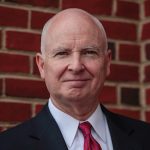“If APJs were not properly appointed yesterday, they cannot not magically be appointed properly today just because a court read their employment rights out of a statute without their representation. I believe this issue is far from resolved.” – Russell Slifer
 Editor’s Note: This article was updated on November 4 to reflect that fellow panelists, and not USPTO Director Iancu, suggested that the Arthrex decision would not have a significant impact.
Editor’s Note: This article was updated on November 4 to reflect that fellow panelists, and not USPTO Director Iancu, suggested that the Arthrex decision would not have a significant impact.
The Federal Circuit’s decision in Arthrex, Inc. v. Smith & Nephew, Inc. generated excitement late last week, when many initially speculated that the Patent Trial and Appeal Board (PTAB) would not be able to continue operations as usual in light of the ruling. However, now that the dust has settled, it seems more likely that the effects of Arthrex will be limited to a small subset of cases. While USPTO Director Andrei Iancu could not comment directly during a panel at the John Marshall Law School’s 63rd IP Conference in Chicago on Friday as it is a pending matter, other panelists suggested that the Office would not be significantly burdened by the decision. USPTO guidance is likely to be issued soon.
Of course, the decision has not done much to bolster the already shaky reputation of the PTAB or its Administrative Patent Judges with some, and there are several scenarios in which the Federal Circuit’s quick fix to avoid shutting down the Board entirely might be challenged. Below are some early reactions to the ruling and predictions about how it may play out.
 Brent Babcock, Womble Bond Dickinson
Brent Babcock, Womble Bond Dickinson
The next steps in this developing legal story remain uncertain. Smith & Nephew could seek a rehearing by the same Federal Circuit panel, as well as a rehearing en banc by the entire Federal Circuit. In addition, Smith & Nephew could appeal the Federal Circuit’s decision to the U.S. Supreme Court via a writ of certiorari. So, yesterday’s panel decision is not set in stone. In any event, in the near term, we can expect that the USPTO will issue guidance very soon on how the PTAB plans to implement the Federal Circuit’s Arthrex decision. In the wake of SAS Institute Inc. v. Iancu in 2018, the Federal Circuit issued guidance two days later.
What we do know, however, is that the Federal Circuit’s decision—if it remains law of the land—will likely have a significant impact of dozens of current cases in the “Arthrex window”. These are cases (a) in which the PTAB has issued a Final Written Decision (FWD), and (b) which still can (or already have) timely introduce(d) an Appointments Clause challenge at the Federal Circuit. Notably, the Federal Circuit found that Arthrex’ s failure to make such a challenge with the Board did not constitute a waiver of that argument because “the Board could not have corrected the [Constitutional] problem.”
The USPTO will likely take whatever corrective measures are necessary to ensure that all current and future APJs’ appointments are Constitutional (viz., such that their removal can be at the will of the Director). For cases in which the PTAB panel has not yet issued a FWD, the PTAB’s corrective APJ appointment measures should cure this particular Constitutional problem going forward. For cases in the “Arthrex window,” however, the impact will probably be considerably greater. The PTAB will likely assign a new panel of different APJs and set a new date for a second final hearing, unless those changes are waived by both parties.
Like with the SAS Institute decision, these interim impacts will be significant on dozens of cases, but the practical impacts will be only temporary. Once the “Arthrex window” cases have moved through the system, the PTAB practice should remain essentially unchanged, both substantively and procedurally. It will nonetheless be interesting for future commentators to evaluate whether these interim impacts from the Arthrex decision result in any substantive changes in the outcomes of the affected cases.
 Matthew Dowd, Dowd Scheffel PLLC
Matthew Dowd, Dowd Scheffel PLLC
The Arthrex decision offers some for all sides and is a bit of a Rorschach test in terms of effects moving forward. For those who have been fighting against what they see as PTAB abuses, this decision confirms the fundamentally unconstitutional structure of the PTAB. For those who see the PTAB as an efficient venue for cancelling patents that, in their view, never should have issued, the decision is a minor obstacle to that process. The Federal Circuit panel tried to limit the impact of this decision to other pending PTAB cases when it wrote: “[W]e see the impact of this case as limited to those cases where final written decisions were issued and where litigants present an Appointments Clause challenge on appeal.” But it is not clear if the impact will be so limited. First, to what extent will parties moving forward be permitted to raise the same issue? In pending appeals before the Federal Circuit, parties will likely be able to raise the issue, but what if the opening brief was already filed? Will the court deem the issue waived? That would seem to be a harsh result for “an issue of exceptional importance,” as the panel put it. Also, the panel’s prescribed remedy seems open to attack. Is it sufficient for a new PTAB panel to re-decide the case on remand on the existing written record, as the court indicated? For instance, the court noted the “significant discretion” of the APJs when holding that the APJs are not inferior officers. That “significant discretion” includes evidentiary decisions during the [America Invents Act] proceeding—some of which may be critical to the proceeding’s outcome and the final written decision. If an “unconstitutional” PTAB panel made a case-dispositive evidentiary ruling, why should a later “constitutional” PTAB panel be bound by that decision? These are just some of the unanswered legal questions created by Arthrex.
 Stephen Kunin, Maier & Maier
Stephen Kunin, Maier & Maier
It appears that until such time as the statute can be revised by Congress and signed into law to correct the current constitutional infirmity, the USPTO must treat APJs as at will employees who are not subject to the Title 5 employment protections available to other federal employees in order for APJs to continue to decide AIA trials. It would not surprise me if the Department of Commerce and the OPM will have to intervene and provide guidance to the USPTO on what it must do and how to do it. The consequence, as I see it, if this is the outcome, is that those in the patent community who have an axe to grind may see this as an opportunity to publicly campaign for the removal of certain APJs who they are displeased with for whatever reason. I can see this as having an adverse impact on APJ morale. It also will put pressure on the USPTO to formulate new personnel policies for handling complaints while still treating APJs fairly. I wish that there was a better solution through a quick and easy fix to the Appointments Clause problem, but the decision thoroughly addressed the options and the arguments of the government and applied a patch that ultimately puts APJs at risk. I am not sure that seeking Department of Justice approval to seek certiorari will necessarily be successful in overturning this decision. Also, note that one possible solution under 35 USC 6 is to have three of the Director, the Deputy Director, the Commissioner for Patents, and the Commissioner for Trademarks review and ratify the APJ decisions in AIA trials.
 Josh Malone, Bunch O’ Balloons
Josh Malone, Bunch O’ Balloons
Now we will see if Director Iancu is serious about restoring integrity to the patent system. If less than 100 APJs are out of a job by the end of the year, cronyism is here to stay. We are prepared to convene panels of three inventors to hold a hearing for each APJ to show cause why they shouldn’t be fired.
 Paul Morinville, US Inventor
Paul Morinville, US Inventor
This is good news and bad news. Iancu now has the opportunity to rid the PTAB of judges who are totally anti-patent. However, patents will now swing in value with every new president and USPTO Director. I have to ask the folks who support the PTAB, is this good public policy?
 Russell Slifer, Schwegman Lundberg & Woessner
Russell Slifer, Schwegman Lundberg & Woessner
The panel appeared to limit the consequences of its decision by holding it to a narrow class of cases. Specifically, the decisions states that: “We have decided only that this case, where the final decision was rendered by a panel of APJs who were not constitutionally appointed and where the parties presented an Appointments Clause challenge on appeal, must be vacated and remanded. Appointments Clause challenges are ‘nonjurisdictional structural constitutional objections’ that can be waived when not presented. Thus, we see the impact of this case as limited to those cases where final written decisions were issued and where litigants present an Appointments Clause challenge on appeal.”
It is how the court decided to correct the statute’s constitutional problem that should raise concern for the USPTO. The court held that 35 U.S.C. § 3(c)’s provision that USPTO officers and employees are subject to Title 5 cannot constitutionally be applied to Board members with respect to that Title’s removal restrictions, and thus must be severed. In other words, the court decided to sua sponte remove statutory employment protections from APJs, without their representation, to correct a different statutory problem.
35 USC 3(c) states that “Officers and employees of the Office shall be subject to the provisions of title 5, relating to Federal employees.” This is a clear unambiguous statute that does not need judicial interpretation. Title 5 shall apply to all employees of the USPTO. What could be clearer?
If the USPTO believes that the court’s remedy of limiting 35 USC 3(c) to only some USPTO employees is a proper solution to solving the unconstitutional appointment of APJs, the PTAB can simply wait for the court to remand all appealed final decisions that properly appealed the APJs appointment. But what happens if this panel was wrong? What if the narrowest viable approach to remedying the violation of the Appointments Clause is not to deny the APJs their rights? Perhaps the narrowest approach would be to address the statute, which was deemed unconstitutional. After all, the decision found a two-pronged problem in the lack of any presidentially-appointed officer who can review, vacate, or correct decisions by the APJs, combined with limited removal power, make APJ’s principal officers. The better solution would be for Congress to grant the Director the right to overrule a Final Decision.
Every post-grant case will now include an appointments challenge on appeal and the USPTO cannot rely on this decision to correct the statutory deficiency. If APJs were not properly appointed yesterday, they cannot not magically be appointed properly today just because a court read their employment rights out of a statute without their representation. I believe this issue is far from resolved.

Robert Stoll, Drinker Biddle
As a patent attorney, this is outside my wheelhouse, but NOW they make this ruling? Shouldn’t this have happened before thousands of PTAB cases were handed down?
 Jonathan Stroud, Unified Patents
Jonathan Stroud, Unified Patents
The Federal Circuit showed admirable restraint in making this narrow change to what statutory removal protections apply to APJs. While it is sure to be another administrative headache for Director Iancu and the Board—depending on how lenient other panels are with waiver—it is clear there was nothing the agency could have done to address these concerns. It was a statutory defect that only the Federal Circuit could solve, and in the end the tweak simply gives the Director the power to remove APJs directly, while recognizing the import of the fairness and expertise the three-judge process affords.
 Gene Quinn, IPWatchdog
Gene Quinn, IPWatchdog
Clearly, the panel was attempting to prevent Pandora’s Box from opening with respect to past decisions of an unconstitutionally constituted PTAB by saying that this argument, unlike jurisdiction, can be waived. Those who did not raise the constitutional infirmity of the PTAB are out of luck even though those “judges” of the PTAB were never proper judges in the first place. That has to be a nightmare scenario for the Patent Office, and a very difficult pill to swallow for those who lost their patents on decisions made by those who had no business being PTAB judges in the first place.
Similarly, the panel prevented Pandora’s Box from opening by fixing the statute rather than finding the statute unconstitutional. By making APJs removeable at will by the Director of the USPTO, they are, in the view of the panel, inferior officers who do not need Presidential nomination and confirmation by the Senate.
Still, this is a significant decision for all patent owners with pending cases before the PTAB or on appeal to the Federal Circuit. It is imperative that every patent owner challenge the constitutionality of the panel rendering the decision under the Appointments Clause, otherwise the argument is waived. This opens up further argument about whether APJs really are exempt from the Appointments Clause.
In short, this decision will shine much-needed light on the practices and procedures of the PTAB and the tribunal’s cavalier attitude toward the work product of examiners and rights of patent owners. It also has the byproduct of making APJs employees at will who can be removed by the Director, which is a power that could become quite handy should Director Iancu find it necessary to remove judges who refuse to play by the rules of the Office.
 John White, Berenato & White
John White, Berenato & White
This decision is the result of Congress wanting to save the Judiciary the burden of dealing with “bad patents”. It created a sham quasi-judicial proceeding within the USPTO. The APJs were and are and will remain accountable to no one. This proposed “severance” regarding removal does little; the prospect of removal for anything other than gross malfeasance is extremely remote. But, nevertheless, good for the CAFC to see through this; but too late for those who have had their patents butchered through this unconstitutional IPR process. Well, better late than never I suppose.
Image Source: Deposit Photos
Image ID: 16891083
Copyright: bloomua

![[IPWatchdog Logo]](https://ipwatchdog.com/wp-content/themes/IPWatchdog%20-%202023/assets/images/temp/logo-small@2x.png)

![[[Advertisement]]](https://ipwatchdog.com/wp-content/uploads/2023/01/2021-Patent-Practice-on-Demand-1.png)
![[Advertisement]](https://ipwatchdog.com/wp-content/uploads/2024/04/Artificial-Intelligence-2024-REPLAY-sidebar-700x500-corrected.jpg)
![[Advertisement]](https://ipwatchdog.com/wp-content/uploads/2024/04/Patent-Litigation-Masters-2024-sidebar-700x500-1.jpg)

![[Advertisement]](https://ipwatchdog.com/wp-content/uploads/2021/12/WEBINAR-336-x-280-px.png)
![[Advertisement]](https://ipwatchdog.com/wp-content/uploads/2021/12/2021-Patent-Practice-on-Demand-recorded-Feb-2021-336-x-280.jpg)
![[Advertisement]](https://ipwatchdog.com/wp-content/uploads/2021/12/Ad-4-The-Invent-Patent-System™.png)






Join the Discussion
17 comments so far.
Anon
November 5, 2019 08:52 amSc,
Your post does not address the factual distinction that examination and adjudication are different things.
There is a reason why examiners must examine under the law, and there is a reason why the January 2019 protocol changed the way that examiners had to examine for eligibility (I’ve mentioned this previously, albeit not of late):
The manner in which the courts approached eligibility was a method of judicial conduct called Common Law law writing. This is employed by members of the judicial branch in a number of proper circumstances in order to “fill in the gaps” in an interpretive manner.
Of course, the juridical branch has been using Common Law law writing in an improper manner in regards to eligibility (more than merely gap filing).
But even that tool (be it proper or improperly wielded), is not a tool available to examiners.
Because, among other things, examiners are not judges.
Sanity check
November 5, 2019 04:45 am@Anon-sequitur
I do “understand the concept of examination versus adjudication.” I also understand that the Supreme Court of the United States held in Cuozzo that IPRs are a “hybrid” of examination and adjudication, which makes your alleged distinction irrelevant.
I likewise understand that the Constitution of the United States does not say anything about a distinction between examination and adjudication, nor does any decision among the multitudinous cases interpreting and applying the Appointments Clause draw such a distinction.
And with good reason — the Appointments Clause focuses on accountability when the government makes a final action that affects the public. The public is not just patent applicants or owners; it is the citizens who must live with the government’s decisions. In this situation, those decisions are made by a beleaguered examiner with limited resources and without input from anyone other than the person seeking to limit all American citizens’ liberty in his/her favor. And increasingly (now more than 50% of the time) that person is not even an American citizen with rights under the Constitution.
Amid all of this, a panel of the Federal Circuit declared during the Polaris oral argument that (another panel of) the Federal Circuit acted illegally on October 31. (See Brian’s comment #14 above.) Maybe that is noteworthy.
Sanity check
November 4, 2019 06:33 pm@mike
The Leahy-Smith America Invents Act did not amend 35 USC 3(c), so the severability provisions in that Act are irrelevant for constitutional decisions affecting that statute. Unless, of course, your argument is that all of Title 35 is now suspect constitutionally, which seems unsupportable and likely not in line with your policy aims.
Brian
November 4, 2019 06:19 pmhttp://www.717madisonplace.com/?p=10788
Polaris v. Kingston
Following on the heels of the Federal Circuit decision in Arthrex last week by Judges Moore, Chen and Reyna, a new panel consisting of Judges Reyna, Wallach, and Hughes heard the oral argument in Polaris v. Kingston this morning.
This oral argument was dedicated entirely to the issue of the constitutionality of PTAB judges and the effect of the Arthrex decision.
The entire oral argument is worth a listen; however, here are some points of note:
Polaris suggested that the court’s correction of the statute that was implemented in Arthrex is insufficient and recommended the nuclear option — invalidate the statute; then let Congress fix it.
The government needs to check in with various agencies as well as the Solicitor General before deciding whether to request en banc review. It sounded as if the government might not reach a decision on whether to request en banc review for another 42 days.
The lack of an issued mandate in Arthrex is causing procedural obstacles. Polaris v. Kingston is perhaps a better vehicle for en banc review given the issues at play; but, the Polaris court can’t apply Arthrex until the mandate issues. So, the timing of a decision in Polaris will be tricky to keep Arthrex and Polaris on relatively parallel tracks for en banc review requests. (Meanwhile, in Customedia v. Dish, decided last week, the CAFC applied Arthrex — prior to a mandate issuing in Arthrex !?!)
There are lingering due process issues with respect to the Director’s instruments of persuasion for controlling Board members.
This constitutionality challenge has been raised once before prior to the Arthrex case. Apparently, in one of the Trading Technologies cases, the issue was raised and the Federal Circuit issued a Rule 36 Judgment. I believe that panel was Judges Newman, Dyk, and Wallach.
The government believes that it was not permitted to use a statutory right when the government was not given a chance to intervene in the Uniloc case that was remanded to the Board last week in view of Arthrex:
Anon
November 4, 2019 05:49 pmSc,
I do not think that you understand the concept of examination versus adjudication.
Sanity check
November 4, 2019 05:19 pmTo all of those PTAB haters dancing on the PTAB’s “grave,” beware what your logic brings — examiners who issue patents are making final agency actions that have effects in the real world; just as PTAB judges do. Under your logic, all existing patents almost certainly are invalid because they were illegally issued by unconstitutionally-appointed principal officers. There has been no statutory fix to make examiners even inferior officers, much less “at will” employees, so the same will be true for patents issued this Tuesday and every Tuesday thereafter until something changes. But congratulations on your Pyrrhic victory!
Daniel Hanson
November 4, 2019 02:58 pmFor a discussion about preserving constitutional issues before the USPTO, see “Elgin v. Dept. of the Treasury and Preserving Constitutional Issues Before the USPTO,” published on IPWatchdog.com on March 5, 2019. That essay observes that generally, constitutional issues must be preserved before an administrative agency, especially when it is necessary to make an evidentiary record and when the agency is capable of taking action to avoid the constitutional problem.
In the most recent Arthrex case, no record was needed, and there was nothing the agency could do to fix the problem. So the Federal Circuit did not require that the issue be presented to the agency prior to appeal.
There was a pre-Elgin Federal Circuit case, In re DBC, 545 F.3d 1373 (Fed. Cir. 2008), in which the Federal Circuit observed that a party generally may not challenge an agency decision on a basis that was not presented to the agency, and that includes constitutional issues. The constitutional issue in DBC was similar to that urged on appeal in Arthrex, yet waiver was found in the former case but not in the latter, on the grounds that there was something the agency could have done to address the particular issue in DBC.
The DBC case was also cited in Celgene Corp. v. Peter, where the constitutional issue was not deemed waived because there were good reasons for not raising it earlier, and because there was no way for the agency to address the issue in a manner that could be reviewed by an Article III court. And DBC was also cited in the earlier (August 21, 2019) case of Arthrex v. Smith & Nephew, Inc., in which a constitutional challenge similar to Celgene was not deemed waived, though it was given short shrift.
The bottom line: argue the constitutional issues to the agency to avoid concerns about waiver; don’t hold the issues in reserve until appeal. The Federal Circuit properly cut some slack to recent litigants, but don’t assume the Court will extend the same courtesy to you.
concerned
November 4, 2019 10:57 amTrace:
Some of the bias may be due to the belief that the whole patent process is concerning all the way up and down the ladder.
The USPTO examiners have done some pretty concerning things in my prosecution. One of the most concerning, among others, is the fact the examiners keep dropping the words “overlooked SSDI” from our claims and adding the word “routine” in every one of their responses. The examiners are trying to (intentionally) paint a picture that all my process does is the routine processing of SSDI benefits. This omission of “overlooked” by both examiners is very concerning and the examiners’ assessment is not factual. We do not process one routine SSDI claim ever!
When the dissent in American Axle says the record was mis-stated, when a court rules judges are unconstitutionally appointed, when other (Berkheimer) court has to remind the legal community that facts matter in a legal setting, the posters on this website are probably not going to hold hands and sing “Kumbaya.”
SH
November 4, 2019 07:58 amIs an “at will” employed panel a due process violation? 14th amendment case law requires independent decisionmakers. Shouldn’t the 5th amendment also require this?
Trace
November 3, 2019 10:00 pmI appreciate this thorough analysis, but I wish it were a little less biased. There seems to be minimal room for pro-PTAB voices.
mike
November 3, 2019 08:30 pm@Anon. Thanks. Can someone point to the Manager’s Amendment exchange?
mike
November 3, 2019 08:29 pmFacts:
– The severability amendment was designated and read.
– Mr. Smith urged his colleagues to support the severability amendment.
– It was stated that Ms. Waters did not want the severability amendment added.
– Mr. Watt asked for unanimous consent to withdraw the amendment.
– None of the Members of the House, not even Mr. Smith, objected to the withdrawal of the severability amendment.
– The severability amendment was withdrawn.
===
With those facts, one can conclude that it was the intent of Congress to not include the severability amendment. Thank you Ms. Waters for not wanting the severability amendment added, and thank you, the entire House, for following her lead by not objecting to its withdrawal when initiated by Mr. Watt.
🙂
Anon
November 3, 2019 06:27 pmmike @ 1,
More comments provided on the other thread – see post 33 (in addition to 30 and 32).
Concerned
November 3, 2019 04:22 pmWe are preparing our PTAB rebuttal to the examiner’s response. Should I raise this constitutional issue?
BTW: I find the conduct of my two examiners very concerning as well.
Thank you.
Anon
November 3, 2019 04:07 pmThere are other collateral issues being raised in the discussion portions of several blogs.
– the propriety itself of the Judicial Branch rewriting law (even if that rewriting is by parsing)
– the validity of the follow-on cases in regards to waiver (apparently not following the controlling Supreme Court line of reasoning, but instead following a 6th circuit case, a (self-admitted not precedential) 10th circuit case, and dicta from a Supreme Court concurrence
– whether or not the parsing itself is possible, in possible view that the AIA may (even if the CAFC did not find it) have indicators of Congressional intent such that the AIA changes in law are non-severable.
Pro Say
November 3, 2019 03:16 pmUnder our Constitution, the CAFC doesn’t have the legal authority to crystal ball mind-read what they believe Congress would want or do.
The PTAB death squad must fall.
Mr. Director: You know what you must do.
All PTAB trials must immediately be cancelled. No new ones can be instituted.
The reign of terror on American innovation by the PTAB must end.
mike
November 3, 2019 01:32 pmRegarding severability:
Taken from https://www.congress.gov/congressional-record/2011/06/23/house-section/article/H4480-1
Note that there may be other versions and discussions of the bill and severability to uncover.
=====================
Amendment No. 11 Offered by Mr. Watt
The Acting CHAIR. It is now in order to consider amendment No. 11 printed in part B of House Report 112-111.
Mr. WATT. Madam Chair, we were expecting Congresswoman Waters. I would ask unanimous consent that this amendment be delayed until we can determine whether she is still planning to offer it.
The Acting CHAIR. The Committee of the Whole is unable to reorder the amendments.
Mr. WATT. In that case, I offer the amendment as the designee of the gentlewoman from California.
The Acting CHAIR. The Clerk will designate the amendment.
The text of the amendment is as follows:
Page 139, insert the following after line 12 and redesignate succeeding sections (and conform the table of contents) accordingly:
—
SEC. 29. SEVERABILITY.
If any provision of this Act or amendment made by this Act, or the application of a provision or amendment to any person or circumstance, is held to be unconstitutional, the remainder of this Act and amendments made by this Act, and the application of the provisions and amendment to any person or circumstance, shall not be affected by the holding.
—
The Acting CHAIR. Pursuant to House Resolution 316, the gentleman from North Carolina (Mr. Watt) and a Member opposed each will control 5 minutes.
The Chair recognizes the gentleman from North Carolina.
Mr. WATT. Madam Chair, I yield myself such time as I may consume solely to say that this is a straightforward amendment that provides that if one part of the bill is determined to be unconstitutional, it can be severable from the rest of the bill and it doesn’t bring the rest of the provisions down. That’s a standard policy to put in most legislation. With that, I reserve the balance of my time.
Mr. SMITH of Texas. Madam Chair, I rise to claim the time in opposition, although I support the amendment.
The Acting CHAIR. Without objection, the gentleman is recognized for 5 minutes.
There was no objection.
Mr. SMITH of Texas. I thank the gentleman for offering the amendment, and I urge my colleagues to support it. I yield back the balance of my time.
Mr. WATT. Madam Chair, I have just been advised that we were mistaken in the desire of Ms. Waters to offer the amendment. She didn’t want me to offer it in her stead, and that’s why she didn’t show up. I would just ask unanimous consent to withdraw the amendment, unless the chairman has an objection.
The Acting CHAIR. Without objection, the amendment is withdrawn.
There was no objection.
===================
Now, follow the dialog:
Mr. Watt offered the severability amendment, saying “That’s a standard policy to put in most legislation.”
Of his own admission, Mr. Watt says it is standard to put it in, so he admits the standard is not to leave it absent and let “default severability” kick in if needed, but the standard policy is “to put in”.
Mr. Smith rose to claim time in opposition and said, “I support the amendment.” Once recognized, he said “I thank the gentleman for offering the amendment, and I urge my colleagues to support it.”
Why would Mr. Smith feel the need to urge his colleagues to support it, if severability was a default?
Mr. Watt then says “I have just been advised that we were mistaken in the desire of Ms. Waters to offer the amendment.”
Now we know Ms. Waters does not want to offer the amendment for severability (“[they] were mistaken in the desire of Ms. Waters to offer the amendment”).
Mr. Watt continues, “[Ms. Waters] didn’t want me to offer [the amendment for severability] in her stead.”
He NEVER SAID “Ms. Waters wanted to offer the amendment.” Also, he did NOT SAY “Ms. Waters wanted to offer the amendment in my stead.” Assuming either of those is assuming words not expressed nor spoken.
All we have is “[Ms. Waters] didn’t want me to offer [the amendment for severability] in her stead.”
And he then adds “That’s why [Ms. Waters] didn’t show up,” NOT because SHE wanted to offer the amendment instead of Mr. Watt, but because SHE DIDN’T WANT MR. WATT TO OFFER THE AMENDMENT. Again, “[they] were mistaken in the desire of Ms. Waters to offer the amendment”. Those are the words recorded.
Then, Mr. Watt says, “I would just ask unanimous consent to withdraw the amendment”.
He didn’t say he say he wanted it removed because severability is the default. He said that Ms. Waters didn’t want to offer the amendment.
Notice that the amendment had already been designated.
The Acting CHAIR then said “Without objection, the amendment is withdrawn.”
With the amendment already designated, now there was opportunity to object to its withdrawal. No one objected. Not even Mr. Smith. Mr. Smith previously felt the need to urge his colleagues to support the amendment, yet now he did not speak up in objection on its withdrawal.
What is important to note is that Ms. Waters never offered the amendment later.
So…
Ms. Waters did not want the amendment added. Mr. Smith urged his colleagues to support it. All members of the House, even Mr. Smith, had the opportunity to object to its withdrawal after it had already been designated. They did not.
With those facts, one could conclude that it was the intent of Congress to not include the severability amendment.
================
All the cards shall fall.